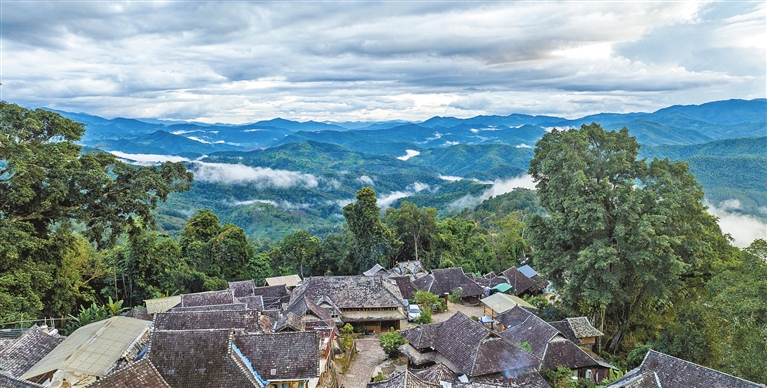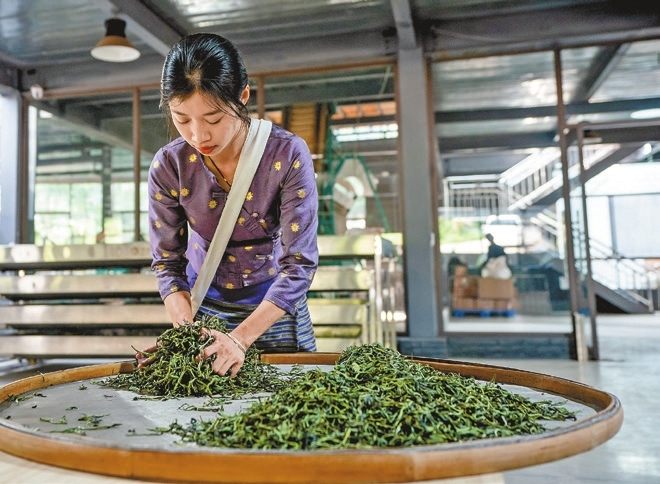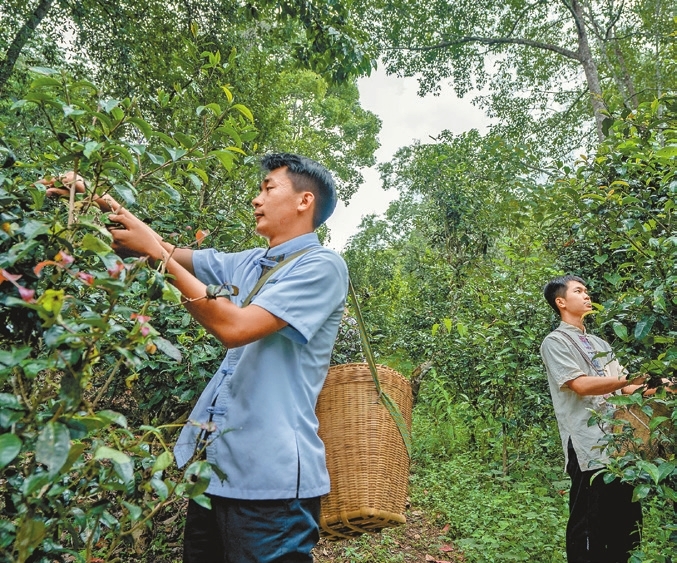


THE Cultural Landscape of Old Tea Forests of Jingmai Mountain in Pu’er, Southwest China’s Yunnan Province was inscribed onto the UNESCO World Heritage list Sept. 17 during the 45th session of the World Heritage Committee in Riyadh, Saudi Arabia. This designation makes it the first World Heritage site for tea culture and brings the total number of China’s sites on the list to 57. The local administration and villagers have worked closely together over the past 12 years in conserving traditional villages, old tea plantations and forests. By incorporating advanced and scientific methods into traditional tea processing, the local community has been able to lift themselves out of poverty and improve the quality of life for the residents. Located in the city of Pu’er, the Cultural Landscape of Old Tea Forests of Jingmai Mountain encompasses nine traditional villages, three old tea plantations that have been operated and managed by villagers for generations, and three partition forests. The local villagers are greatly appreciative of the gifts of nature, and they cherish every inch of land, considering the ancient tea forests as an integral part of their lives. Gift from ancestors The property was jointly created by the ancestors of the Blang people who migrated to Jingmai Mountain in the 10th century and discovered and domesticated wild tea trees, and by the ancestors of the Dai people, who later settled there. As a multi-ethnic settlement, Jingmai Mountain still preserves the languages, music, customs and festivals of different ethnic groups, adding more unique charm to the ancient tea forests. Local villagers show their reverence for their ancestors and nature, and celebrate their legacies with various festivals, such as the Blang ethnic group’s Shankang Festival and the Dai ethnic group’s Water Splashing Festival. The Blang people believe every tea tree has a spirit. For this reason, a secret ritual passed down generations is held before they begin picking tea leaves. The aboriginal peoples had developed a smart tea growing technique, creating ideal light conditions for the growing of tea trees through limited understory cultivation. Such a method can prevent insect hazards through a well-preserved forest ecosystem, which guarantees the quality of organic tea leaves. Chen Yaohua, director of Peking University’s World Heritage Research Center, says that as the first tea culture heritage site in the world, the inscription of the Cultural Landscape of Old Tea Forests of Jingmai Mountain is of great significance for tea culture. Production sites for beverages such as wine and coffee have long been inscribed on UNESCO’s World Heritage list. He explains that the understanding and support of local villagers was crucial to the success of its inscription. Due to their Buddhist beliefs, each village has a “Buddha Master” who recites scriptures that often integrate Buddhist preaching with local matters. “The local Buddha masters strongly supported the inscription project and created music videos on the subject to share with the villagers. The villagers then readily embraced the project,” said Chen, adding that the harmonious social relations in these ethnic minority communities contributed to the smooth preparation for the inscription. A self-sufficient eco-zone The new World Heritage Site is home to more than 900 kinds of plants and 340 types of animal species, including insects and terrestrial vertebrates. Besides its iconic “tea tree” label, the site is also a self-sufficient zone of rich biodiversity. Tang Lixin, a staffer with the local development center for the tea and biological industry of Pu’er City’s Lancang County, says the unique climate and environment of the region has made it an independent ecological zone within which plants and animals can nurture each other. As the site is encircled by two rivers, there is adequate and balanced air humidity, which is ideal for trees, particular tea trees. Aside from ancient tea plants, many other plant species are found, one of which serves as the perch for more than 100 honeycombs, making it a perfect example of plant-animal coexistence. Tang adds that such a reciprocal relationship provides possible incomes from new sources such as honey processing in addition to the traditional tea industry. Xiang Kangzuo, a wild animal researcher, has stood witness to the area’s rich animal life, particularly the leopard cat and the birds of the mountain area. Xiang says that the birds keep the tea trees free from vermin. “The value of the biodiversity of the Old Tea Forests of the Jingmai Mountain combines two factors. The first is the number and importance of the area’s natural resources. The second is the autonomous and self-sufficient exchange between the animals and plants,” Xiang says. Both Xiang and Tang emphasize that locals have hardly interfered with the natural order of the region. Tang, however, adds that the ecology of the Old Tea Forests of the Jingmai Mountain wouldn’t be complete if without human contributions. Local people, especially tea farmers, have reached a consensus on not exhausting their tea tree resources for generations. “Selective use and protection are two rules that have never changed,” Tang remarks. Rules such as banning livestock such as sheep from entering the Old Tea Forests is necessary. Locals have also painstakingly avoided using mechanical tools for fear of potential harm from chemical pollution. They insist on hand-picking tea leaves even though manual labor is not cost efficient. Thus far, there are 108 plant species that are unique to Yunnan in the region, of which five are endangered species and 11 are national protected species. In addition to birds, the region is also home to 13 kinds of snakes such as Elaphe taeniura, also known as the “black-eyebrowed snake,” and cobras. A better life With more than 90% of the local labor force employed in the tea industry, Jingmai Mountain has persisted in its tradition of sustainable development. “We practice a moderate utilization of ancient tea trees. Currently, we mainly harvest tea leaves in spring and autumn, while leaving the trees undisturbed during the summer to allow them to accumulate nutrients. The picking is still done manually, and we are careful to leave tender buds on the new shoots,” says Xiangong, an ethnic Dai woman. Ten years ago, Xiangong took the lead in establishing a tea cooperative, which now has 229 participating households. The cooperative has enabled more efficient marketing of the local tea. Chen mentions that an increasing number of young people are choosing to stay in their hometown or return after graduating from universities. Besides harvesting and selling tea, young people can inject new vitality into Pu’er through opening homestays and designing cultural and creative products. Hu Jianrong, a deputy mayor of Pu’er, states that inspired by the millennium-old tea planting experience of Jingmai Mountain, more than 1.36 million acres of tea gardens in the city have been managed ecologically since 2010. Projects such as the Pu’er Tea Processing and Storage Logistics Park and the Tea Horse Ancient Cellar have been established near Jingmai Mountain. This has attracted more businesses and tourists to the area, with the number of visitors reaching 6.15 million in 2022 and generating tourism revenues of 6.24 billion yuan (US$855.2 million). (Global Times) | 
